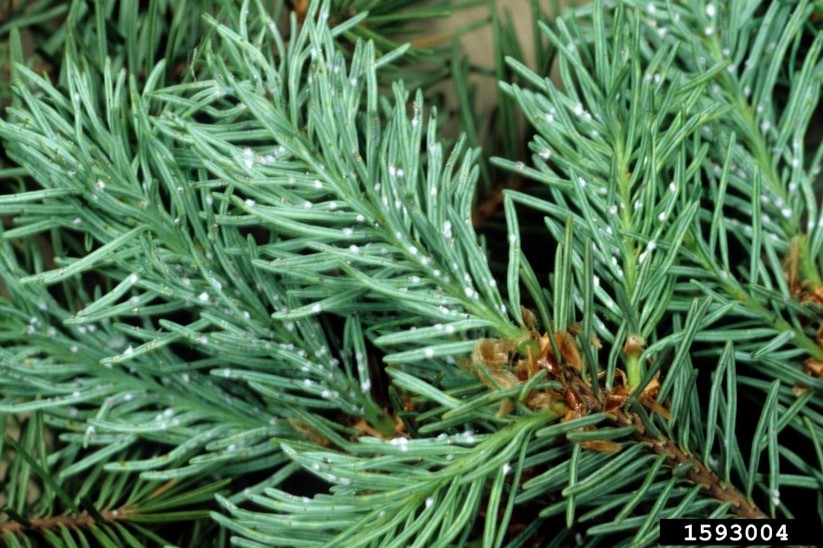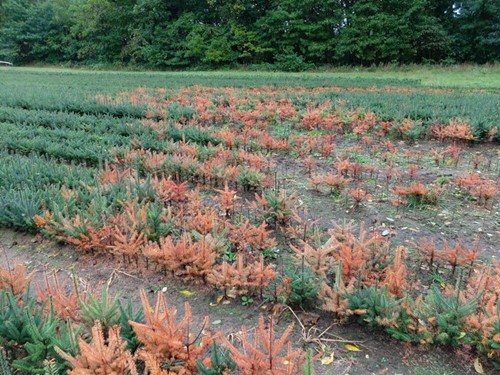Michigan Christmas tree pest update – June 4, 2021
Scout trees now for insect pests.

Gypsy moth larvae
In a previous Michigan State University Extension article “Gypsy moth populations are high: What conifer growers need to know,” we reported that gypsy moth populations were very high across the state. Growers are finding early instar larvae that have blown into plantations from fence rows and woodlots surrounding the field. Make sure you are scouting these areas to detect any problems early. Gypsy moths can cause severe defoliation of spruce, fir and Douglas fir trees and reduce the aesthetic quality of the trees.
These species are at high risk for gypsy moth because they are known hosts of gypsy moth, and the branches and needles are so dense that it is almost impossible to find all the egg masses laid in the tree. Gypsy moth is especially concerning for conifers because they only set buds once a year whereas some deciduous trees, such as oak (a preferred host), will reflush a second set of leaves after being defoliated.
Spruce, fir and Douglas-fir must be treated with an approved pesticide during the required spray window period if you are shipping trees outside of the gypsy moth regulated area.
For more information and treatment recommendations, check out “Gypsy moth populations are high: What conifer growers need to know.”
Aphids on true fir
The characteristic curling of the new growth caused by balsam twig aphid, Mindarus abietinus, is showing up on Fraser and balsam fir trees. Insecticide treatment from this time onward will likely do little to prevent damage as the aphids are well protected within the shoots, making coverage of any insecticide difficult. The good news is that needles will continue to elongate for several weeks. By late summer, the trees should outgrow much of that damage.
If you are seeing heavy damage this summer, plan to apply an insecticide this next spring to kill the stem mothers. According to the MSU Extension Christmas Tree Pest Management Guide 2021, the best time is to target the stem mothers by applying one of the following label insecticides between 100 and 140 growing degree days (GDD). To learn more about balsam twig aphid, check out “Target stem mothers to control balsam twig aphid” from MSU Extension.
On other true firs such as concolor and corkbark, we are currently finding a woolly aphid that is thought to be balsam twig aphid. When we find this aphid, we don’t usually see much damage even with high populations. MSU Extension suggests monitoring trees if there are high populations and the trees will be harvested this year; you may want to apply an insecticide.

Cooley spruce gall adelgid on Douglas fir
Small, white, cottony balls from Cooley spruce gall adelgid can be found on the undersides of needles of Douglas fir. On Douglas fir, feeding from Cooley spruce gall adelgid does not produce a gall but causes yellow spots and bent needles. At this time the eggs are protected under waxy threads.

If populations are heavy, target your insecticide application when the second generation of nymphs are active between 600-1000 GDD with base 50. GDD is calculated based on the amount of heat accumulated over time (based on 50 degrees Fahrenheit). Where are we now? According to MSU’s Enviroweather stations, as of June 1 we are at the following GDD:
|
Location |
GDD on June 1 |
Predicted GDD for June 9 |
|---|---|---|
|
Hudsonville |
497 |
650 |
|
Allegan |
549 |
698 |
|
Romeo |
478 |
620 |
|
Arlene |
403 |
537 |
Therefore, growers will be able to target the second generation of Cooley spruce gall adelgid nymphs likely during mid-June.

Seedling/transplants turning brown

Each year we get questions about newly planted trees that turn brown and, in some cases, die (Photo 5). Young conifer transplants do not have extensive root systems and if the seedling or transplants fail to regenerate new, healthy roots, during the fall or spring, the trees can turn brown and sometimes die.
There are a few possible causes of the death of new transplants. Most growers are of course concerned that brown trees or dead transplants throughout the field could be a sign of root rot, including Phytophthora (Photo 6). In the case of Phytophthora root rot, the damage may be scattered trees throughout the field or in low spots of the field where water accumulates.
The transplants could have also experienced drought since planting or overheating during storage or transportation. The death of young plants could also be a result of poor planting where roots are placed in the soil horizontally when the trench or hole wasn’t deep enough, often called j-rooting.

To learn more about how to scout your Christmas tree farm, see “Prepare your scouting plan for your Christmas trees” from MSU Extension. To learn more about pest management, check out the MSU Extension Christmas Tree Pest Management Guide 2021.



 Print
Print Email
Email




